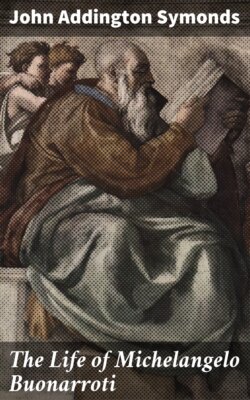Читать книгу The Life of Michelangelo Buonarroti - John Addington Symonds - Страница 9
На сайте Литреса книга снята с продажи.
VI
ОглавлениеAngelo Poliziano, who was certainly the chief scholar of his age in the new learning, and no less certainly one of its truest poets in the vulgar language, lived as tutor to Lorenzo's children in the palace of the Medici at Florence. Benozzo Gozzoli introduced his portrait, together with the portraits of his noble pupils, in a fresco of the Pisan Campo Santo. This prince of humanists recommended Michelangelo to treat in bas-relief an antique fable, involving the strife of young heroes for some woman's person. Probably he was also able to point out classical examples by which the boyish sculptor might be guided in the undertaking. The subject made enormous demands upon his knowledge of the nude. Adult and youthful figures, in attitudes of vehement attack and resistance, had to be modelled; and the conditions of the myth required that one at least of them should be brought into harmony with equine forms. Michelangelo wrestled vigorously with these difficulties. He produced a work which, though it is imperfect and immature, brings to light the specific qualities of his inherent art-capacity. The bas-relief, still preserved in the Casa Buonarroti at Florence, is, so to speak, in fermentation with powerful half-realised conceptions, audacities of foreshortening, attempts at intricate grouping, violent dramatic action and expression. No previous tradition, unless it was the genius of Greek or Greco-Roman antiquity, supplied Michelangelo with the motive force for this prentice-piece in sculpture. Donatello and other Florentines worked under different sympathies for form, affecting angularity in their treatment of the nude, adhering to literal transcripts from the model or to conventional stylistic schemes. Michelangelo discarded these limitations, and showed himself an ardent student of reality in the service of some lofty intellectual ideal. Following and closely observing Nature, he was also sensitive to the light and guidance of the classic genius. Yet, at the same time, he violated the aesthetic laws obeyed by that genius, displaying his Tuscan proclivities by violent dramatic suggestions, and in loaded, overcomplicated composition. Thus, in this highly interesting essay, the horoscope of the mightiest Florentine artist was already cast. Nature leads him, and he follows Nature as his own star bids. But that star is double, blending classic influence with Tuscan instinct. The roof of the Sistine was destined to exhibit to an awe-struck world what wealths of originality lay in the artist thus gifted, and thus swayed by rival forces. For the present, it may be enough to remark that, in the geometrical proportions of this bas-relief, which is too high for its length, Michelangelo revealed imperfect feeling for antique principles; while, in the grouping of the figures, which is more pictorial than sculpturesque, he already betrayed, what remained with him a defect through life, a certain want of organic or symmetrical design in compositions which are not rigidly subordinated to architectural framework or limited to the sphere of an intaglio.
Vasari mentions another bas-relief in marble as belonging to this period, which, from its style, we may, I think, believe to have been designed earlier than the Centaurs. It is a seated Madonna with the Infant Jesus, conceived in the manner of Donatello, but without that master's force and power over the lines of drapery. Except for the interest attaching to it as an early work of Michelangelo, this piece would not attract much attention. Vasari praises it for grace and composition above the scope of Donatello; and certainly we may trace here the first germ of that sweet and winning majesty which Buonarroti was destined to develop in his Pietà of S. Peter, the Madonna at Bruges, and the even more glorious Madonna of S. Lorenzo. It is also interesting for the realistic introduction of a Tuscan cottage staircase into the background. This bas-relief was presented to Cosimo de' Medici, first Grand Duke of Tuscany, by Michelangelo's nephew Lionardo. It afterwards came back into the possession of the Buonarroti family, and forms at present an ornament of their house at Florence.
